Questions about the budget process
Why is this Round 1 of reductions? Why do you need to plan for Round 2?
There are four primary factors that will determine whether we need an additional round of budget reductions. The state legislature is currently in session, and considering legislation that may change school funding for next school year, as well as requirements for schools. We are monitoring inflation, especially for things like utilities, which are likely to increase next year. We will be negotiating contracts with WAE and PSE, which may have an impact. Finally, we are monitoring current spending, as how much we spend this year will be a factor in where we start the next budget cycle.
Why do you have a shortfall?
State Underfunds Education
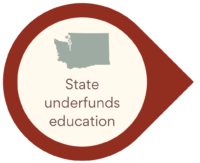 The state underfunds education, leaving significant gaps in funding that must be made up using local resources.
The state underfunds education, leaving significant gaps in funding that must be made up using local resources.
For example, the state does not provide enough in funding for special education, pupil transportation, or school nurses. The state does not provide enough for the cost of insurance, utilities, employee benefits or substitute teachers.
The state funding does not cover the cost of the excellent programs our community expects for students.
Declining Enrollment
 Every year for the past 7 years, the number of students graduating has been bigger than the number of incoming Kindergarten students, typically by 50 or more students.
Every year for the past 7 years, the number of students graduating has been bigger than the number of incoming Kindergarten students, typically by 50 or more students.
Washougal grew rapidly in the early 2000s with the construction of the Sunset Ridge neighborhood. The last of the big wave of students from families that moved in during that period are graduating over the next few years. With each new group of incoming students being smaller, we have a downward trend in enrollment that is expected to continue for a few more years.
As we adjust to serve fewer students, we need fewer staff to maintain student/staff ratios. We are working hard to balance class sizes across the district and ensure high quality programs for students, while being good stewards of public resources.
Inflation
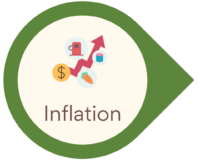 The cost for just about everything has gone up over the past few years, including most of the things a school district needs to serve students. Our district has seen cost increases for utilities, fuel, food, insurance, and staff costs.
The cost for just about everything has gone up over the past few years, including most of the things a school district needs to serve students. Our district has seen cost increases for utilities, fuel, food, insurance, and staff costs.
State funding has not kept pace with the increase in these costs, leading to an increasing gap between what we receive from the state and what it costs to provide an excellent education for every student.
Levy Rollback
 Voters approved $9.5 million in our Educational Programs and Operations Levy (EP&O) for collection starting in tax year 2024. State rules for EP&O levy funds include a rule that caps them based on the number of students a district serves.
Voters approved $9.5 million in our Educational Programs and Operations Levy (EP&O) for collection starting in tax year 2024. State rules for EP&O levy funds include a rule that caps them based on the number of students a district serves.
With our projected enrollment, we are legally required to “roll back” $700,000 in levy funding. These are voter approved property taxes that will NOT be collected. While this results in a lower tax rate for all Washougal property owners, it contributes to a shortfall in our budget.
This rollback also means that the district must consider reductions in items that are paid for by the levy, since the district will not collect all of the funding that was approved by voters.
Questions About the Budget Shortfall
Voters approved an Educational Programs & Operations Levy (EP&O) and Capital Levy in April 2023. This will provide important funds for calendar years 2024, 2025, and 2026. The district can’t collect all of the funds approved by voters due to a per-student cap on levies, so about $700,000 will NOT be collected the first year of the levy, and is part of why there are budget reductions needed. Other costs are still increasing, and student enrollment has declined over the past 7 years. Since we are serving fewer students, we need to make adjustments to reduce expenses, including staff reductions.
Yes. The superintendent has announced that the district will not fill Assistant Superintendent Aaron Hansen’s position when he leaves at the end of the year. As we plan for reductions, there will be additional reductions in administrative positions and reductions in staff who do not work directly with students.
Throughout the budget development process, the school board and district leadership have asked for feedback from the community. The results of the budget survey, which was shared with students, families, staff and the community, are on our budget information page.
District leadership have been sharing updates since Spring 2023 about the financial realities of our shortfall with the school board. The board has scheduled additional opportunities for public input through the board listening tours, and encouraged the superintendent to continue outreach through the Superintendent Roundtable events.
Board members visit school staff and students as part of the board site tours, which take place multiple times per year, spending time listening, asking questions, and answering questions with both students and staff.
Specific dates when information was shared with or gathered from the community
- Spring 2023 – staffing adjustments and realignment in May & June, budget update, administrative pay concessions for 2023-24
- Oct 9, 2023 – Superintendent Roundtable event with budget info and student successes
- Oct 24, 2023 – Board meeting staffing and enrollment update
- Oct 30, 2023 – Recap of 10-24-2023 budget recap shared in Mary’s Monday Minute
- Nov 2, 2023 – Board Listening Tour at Washougal Community Center
- Nov 6, 2023 – Board Enrollment and Staffing update
- Nov 28, 2023 – Board meeting legislative priorities, budget recap
- Dec 4, 2023 – Recap of 11-28-2023 budget recap shared in Mary’s Monday Minute
- Dec 11, 2023 – Budget update from Fall newsletter, including enrollment, funding gap, and more shared in Mary’s Monday Minute
- Dec 12, 2023 – Board meeting Enrollment and Staffing Update
- Dec 18,2023 – Significant reductions needed in 2024-25 included in recap of 12-12-2023 board recap shared in Mary’s Monday Minute
- Jan 11, 2024 – Superintendent Roundtable with budget info and student successes
- Jan 9, 2024 – Budget priorities survey and update on process at Board Meeting
- Jan 10, 2024 – Community invitation to survey, sharing budget info as context sent to all families, posted to social media, and via press release
- Jan 22, 2024 – Budget survey reminder in Mary’s Monday Minute
- Jan 23, 2024 – Board Enrollment and staffing update, $3 million reductions needed
- Jan 29, 2024 – Budget survey reminder in Mary’s Monday Minute, recap of board budget update
- Feb 1, 2024 – Staff survey reminder from Aaron with budget info
- Feb 5, 2024 – Budget website updated, FAQ from survey posted shared in Mary’s Monday Minute
- Feb 13, 2024 – Board Listening Tour at Excelsior
- Feb 13, 2024 – Board work session with budget reduction list
- March 12, 2024 – Board reviewed draft of Modified Educational Program resolution at board work session
- March 19, 2024 – Superintendent Roundtable # 3 (virtual) and #4 in person
- April 9, 2024 – Board Listening Tour at Legion Hall
- April 23, 2024 – Board approves Modified Educational Program resolution during board meeting
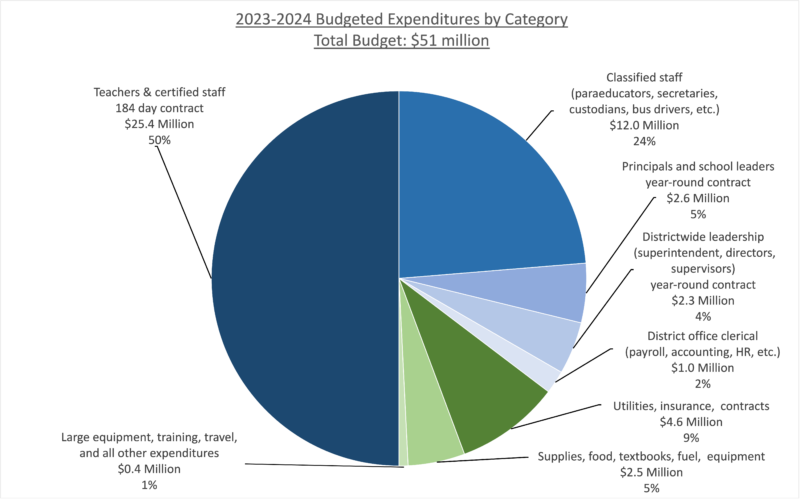
The district spends about 85% of the budget on staff, with the remaining 15% being on contracts, insurance, fuel, utilities, supplies, student meals, equipment, travel, training and other expenses.
Districtwide leadership, including the superintendent, directors, and program supervisors are 4% of the budget. School principals and other leaders are 5% of the budget. District office clerical staff, including payroll, accounting, human resources, and others are 2%.
Booster groups can fundraise and provide donations to support specific activities in coordination with the school principal. Our Boosters are amazing at finding creative ways to keep important programs running, and we value their partnership and support of students!
Only districts under 500 students are allowed to apply for a waiver to do a four-day school week for efficiency reasons. This is part of a state law, RCW 28a.150.222.
The district has been doing this over the past few years, and the ending fund balance, or reserve fund, no longer has enough money left in it to postpone making budget reductions.
This chart shows the historical information related to the ending fund balance, and includes a projection of what would happen if no changes are made.
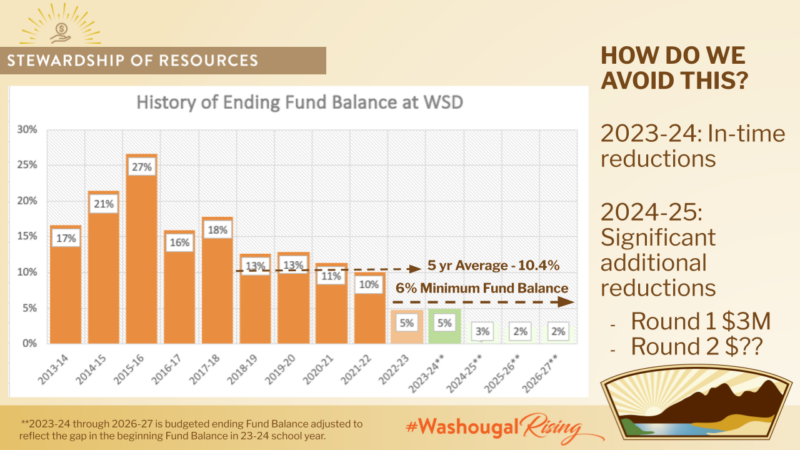
State and local funding does not come to the district in equal amounts each month. In months where state funding is lower, the ending fund balance, or reserve fund, is used to provide cashflow so the district can pay for expenses. Our fund balance currently is below 6%. This means the district may need to borrow funding from our capital fund to pay our payroll. The school board has authorized an inter-fund loan to provide capacity should this happen, and any capital funds are required to be paid back with interest.
When we implement a reduction in force, we follow the negotiated agreement between the district and our labor partners. This means that reductions are based on needed positions and individual teacher seniority, not on an individual basis.
We have heard that students are frustrated about the impact on younger teachers who are working hard to connect with students and create dynamic learning opportunities that challenge students to develop relevant skills to serve them after high school. We are also frustrated by this impact, and we are actively encouraging our students to advocate to the legislature for full funding for education.
No, any proceeds from the sale of property are required to be deposited into the district’s Capital Project Fund, and the use of those funds is restricted under RCW 28a.320.330. These funds can then only be used for renovation or replacement of facilities or other capital improvements. Also, the old bus garage is being used for long term storage of district equipment and classroom furniture that is not currently in use, but may be in the future.
The voter approved levy funds which will be used to replace the high school roof have not been collected yet. The Capital levy includes collections for the roof, boilers, flooring, and security projects, but the funds for those projects won’t be collected until 2025 and 2026. These funds are restricted, and can only be spent on the facility improvements voters approved them for. The funds cannot be transferred to the General Fund to help with the budget shortfall.
We will share additional information about project timelines and the public bidding process later this year. We’re excited to have voter support for these important projects, and we will keep you informed when they start.
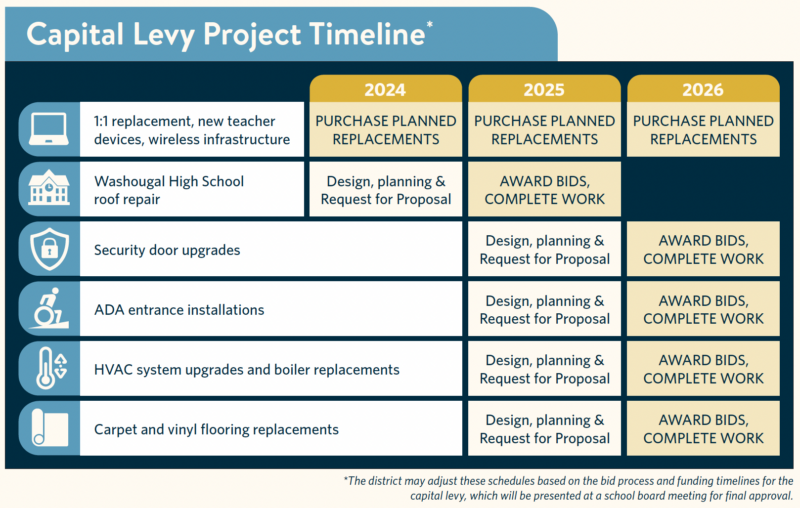
No, school board members are volunteers who are elected by the community to govern our district. Washougal school board members do not receive a salary for this important work.
Washougal School District is one of a number of organizations working together to reduce future costs by investing in the community solar program. The program investment was $8,500.
The investment in the Clark PUD Community Solar program is anticipated to generate a cost savings over the next few years as the panels begin generating electricity. This reduction will reduce future utility costs, and the investment is anticipated more than pay for itself.
Washougal School District has partnered with Clark PUD in the past as part of the CEEP program to increase the efficiency of our lighting system. This work was funded by grant funds, and created an estimated $12,000 in annual utility savings, while also increasing safety around our school campuses.
The district has explored grants and been successful in providing more services through grants like the Drug Free Communities grant, which funds specific positions for substance use interventions. There are many more grants, each of which has specific requirements and funds programs and services our community has asked us to provide.
There are a number of other grants we have explored but not been funded for.
We will continue to try to find creative ways to solve the budget challenges, and we appreciate the ideas surfaced during the community input survey and in-person sessions with community members.
We are working closely with each of our bargaining groups, including those for administrators, as we plan budget reductions. Building administrators and district leaders agreed to a salary concession in July 2023, receiving less of an increase than was provided to other groups. We will share more information about the specific reductions for each group as we reach agreements in the coming months.
Superintendent Dr. Mary Templeton has volunteered to take a reduction in salary and benefits for the 2024-2025 school year of $20,900. She feels a strong responsibility to share in the sacrifice others are being asked to make.
There are about 18 people that work at the District Office, which includes staff who work part time and not year round. Some staff who support district-wide programs are listed in the Staff Directory on our website, but work at other sites. District Office staff manage board governance, district finances, purchasing, payroll and benefits for staff, human resources, special education, technology, communications, and many other tasks. Staff at the District Office work to keep the district in compliance with local, state, and federal rules and regulations, and support the Washington State Auditor’s Office in the yearly audit of all district finances.
The school board and district leaders are advocating for changes to the state funding model for schools to help with this problem. The board identified four priorities to advocate with our legislative representatives, which included fully funding special education; student transportation; addressing the gap between the state allocation for fuel, insurance, utilities, and employee health benefits; and advocating for fully funding the cost of staff, noting that the state falls short by over $21,000 on average for teacher compensation compared to what Washougal spends.
Our legislators are seeking feedback from community members about their priorities as they start the legislative session, and want to hear from you. If you are interested in reaching out, the Legislative Information Center has ways you can contact your representatives.
State funding for teacher salaries falls short by an average of $21,000 per Washougal teacher. The difference must be made up with local funds.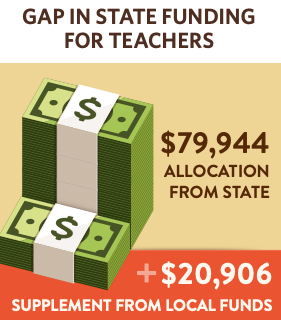
The school board is hosting a Listening Tour about the budget on
February 13 and
April 9. There is also a Superintendent’s Roundtable event on
March 19. Anyone with questions can come to these events and learn about our budget process and share ideas.
Community members, staff, students, or families can also reach out to the Business and Operations Director Kris Grindy, [email protected] to ask questions. You can also schedule a time to meet with Superintendent Dr. Mary Templeton by emailing [email protected] to set up a time.
 The state underfunds education, leaving significant gaps in funding that must be made up using local resources.
The state underfunds education, leaving significant gaps in funding that must be made up using local resources. Every year for the past 7 years, the number of students graduating has been bigger than the number of incoming Kindergarten students, typically by 50 or more students.
Every year for the past 7 years, the number of students graduating has been bigger than the number of incoming Kindergarten students, typically by 50 or more students. The cost for just about everything has gone up over the past few years, including most of the things a school district needs to serve students. Our district has seen cost increases for utilities, fuel, food, insurance, and staff costs.
The cost for just about everything has gone up over the past few years, including most of the things a school district needs to serve students. Our district has seen cost increases for utilities, fuel, food, insurance, and staff costs. Voters approved $9.5 million in our Educational Programs and Operations Levy (EP&O) for collection starting in tax year 2024. State rules for EP&O levy funds include a rule that caps them based on the number of students a district serves.
Voters approved $9.5 million in our Educational Programs and Operations Levy (EP&O) for collection starting in tax year 2024. State rules for EP&O levy funds include a rule that caps them based on the number of students a district serves.





